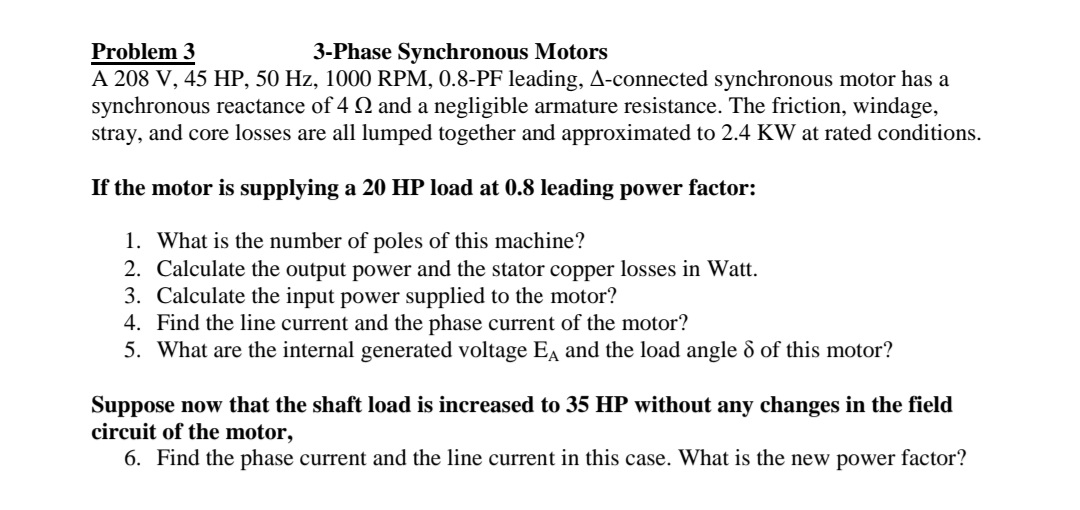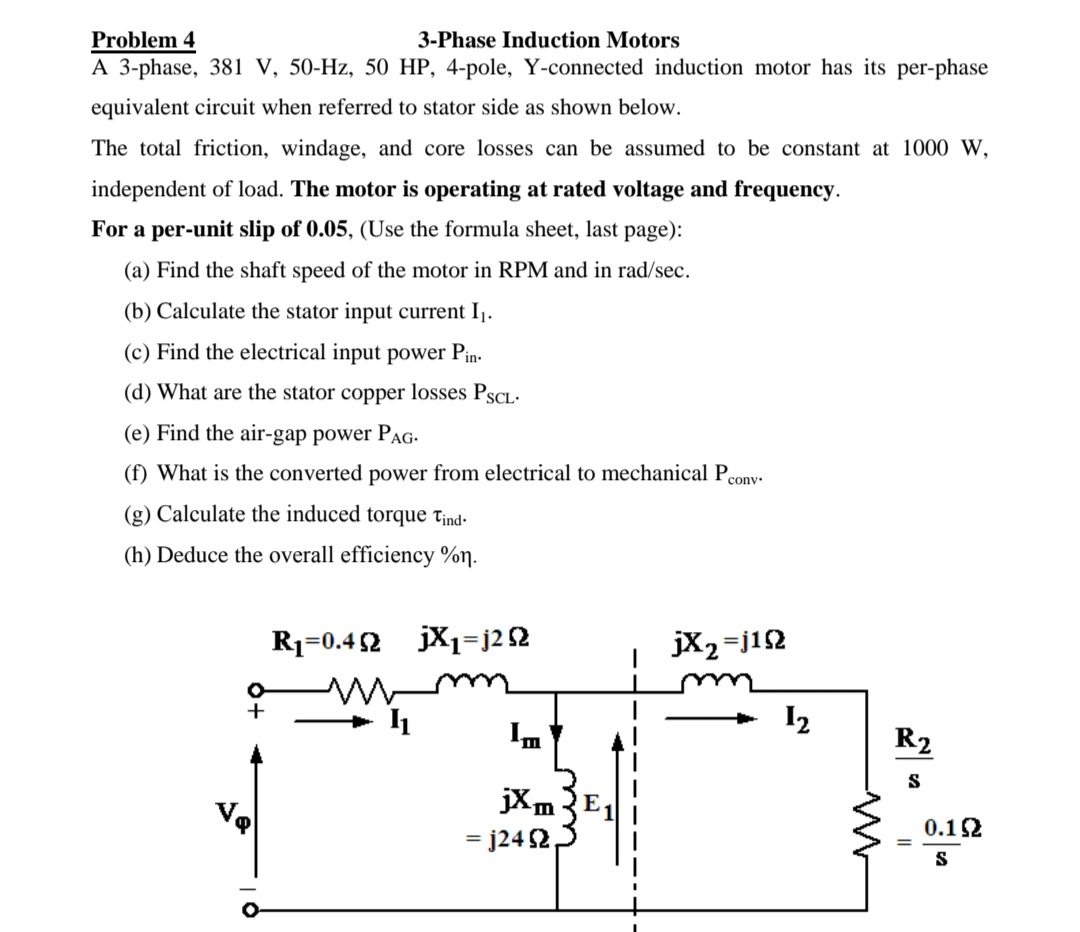Problem 3 A 208 V, 45 HP, 50 Hz, 1000 RPM, 0.8-PF leading, A-connected synchronous motor has a synchronous reactance of 4 2 and a negligible armature resistance. The friction, windage, stray, and core losses are all lumped together and approximated to 2.4 KW at rated conditions. 3-Phase Synchronous Motors If the motor is supplying a 20 HP load at 0.8 leading power factor: 1. What is the number of poles of this machine? 2. Calculate the output power and the stator copper losses in Watt. 3. Calculate the input power supplied to the motor?
Problem 3 A 208 V, 45 HP, 50 Hz, 1000 RPM, 0.8-PF leading, A-connected synchronous motor has a synchronous reactance of 4 2 and a negligible armature resistance. The friction, windage, stray, and core losses are all lumped together and approximated to 2.4 KW at rated conditions. 3-Phase Synchronous Motors If the motor is supplying a 20 HP load at 0.8 leading power factor: 1. What is the number of poles of this machine? 2. Calculate the output power and the stator copper losses in Watt. 3. Calculate the input power supplied to the motor?
Introductory Circuit Analysis (13th Edition)
13th Edition
ISBN:9780133923605
Author:Robert L. Boylestad
Publisher:Robert L. Boylestad
Chapter1: Introduction
Section: Chapter Questions
Problem 1P: Visit your local library (at school or home) and describe the extent to which it provides literature...
Related questions
Question

Transcribed Image Text:Problem 3
A 208 V, 45 HP, 50 Hz, 1000 RPM, 0.8-PF leading, A-connected synchronous motor has a
synchronous reactance of 4 2 and a negligible armature resistance. The friction, windage,
stray, and core losses are all lumped together and approximated to 2.4 KW at rated conditions.
3-Phase Synchronous Motors
If the motor is supplying a 20 HP load at 0.8 leading power factor:
1. What is the number of poles of this machine?
2. Calculate the output power and the stator copper losses in Watt.
3. Calculate the input power supplied to the motor?
4. Find the line current and the phase current of the motor?
5. What are the internal generated voltage Ea and the load angle d of this motor?
Suppose now that the shaft load is increased to 35 HP without any changes in the field
circuit of the motor,
6. Find the phase current and the line current in this case. What is the new power factor?

Transcribed Image Text:Problem 4
A 3-phase, 381 V, 50-Hz, 50 HP, 4-pole, Y-connected induction motor has its per-phase
3-Phase Induction Motors
equivalent circuit when referred to stator side as shown below.
The total friction, windage, and core losses can be assumed to be constant at 1000 w,
independent of load. The motor is operating at rated voltage and frequency.
For a per-unit slip of 0.05, (Use the formula sheet, last page):
(a) Find the shaft speed of the motor in RPM and in rad/sec.
(b) Calculate the stator input current I1.
(c) Find the electrical input power Pin-
(d) What are the stator copper losses PSCL-
(e) Find the air-gap power PAG-
(f) What is the converted power from electrical to mechanical Peony-
(g) Calculate the induced torque t¡nd-
(h) Deduce the overall efficiency %n.
R1=0.42
jX1=j2 52
jX2=j12
+
I2
R2
S
jXm
= j24 2,
0.12
S
Expert Solution
This question has been solved!
Explore an expertly crafted, step-by-step solution for a thorough understanding of key concepts.
This is a popular solution!
Trending now
This is a popular solution!
Step by step
Solved in 2 steps

Knowledge Booster
Learn more about
Need a deep-dive on the concept behind this application? Look no further. Learn more about this topic, electrical-engineering and related others by exploring similar questions and additional content below.Recommended textbooks for you

Introductory Circuit Analysis (13th Edition)
Electrical Engineering
ISBN:
9780133923605
Author:
Robert L. Boylestad
Publisher:
PEARSON

Delmar's Standard Textbook Of Electricity
Electrical Engineering
ISBN:
9781337900348
Author:
Stephen L. Herman
Publisher:
Cengage Learning

Programmable Logic Controllers
Electrical Engineering
ISBN:
9780073373843
Author:
Frank D. Petruzella
Publisher:
McGraw-Hill Education

Introductory Circuit Analysis (13th Edition)
Electrical Engineering
ISBN:
9780133923605
Author:
Robert L. Boylestad
Publisher:
PEARSON

Delmar's Standard Textbook Of Electricity
Electrical Engineering
ISBN:
9781337900348
Author:
Stephen L. Herman
Publisher:
Cengage Learning

Programmable Logic Controllers
Electrical Engineering
ISBN:
9780073373843
Author:
Frank D. Petruzella
Publisher:
McGraw-Hill Education

Fundamentals of Electric Circuits
Electrical Engineering
ISBN:
9780078028229
Author:
Charles K Alexander, Matthew Sadiku
Publisher:
McGraw-Hill Education

Electric Circuits. (11th Edition)
Electrical Engineering
ISBN:
9780134746968
Author:
James W. Nilsson, Susan Riedel
Publisher:
PEARSON

Engineering Electromagnetics
Electrical Engineering
ISBN:
9780078028151
Author:
Hayt, William H. (william Hart), Jr, BUCK, John A.
Publisher:
Mcgraw-hill Education,